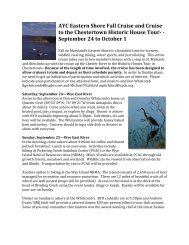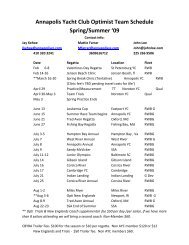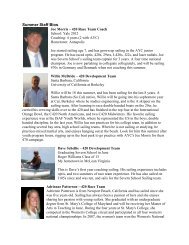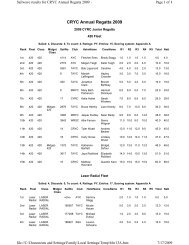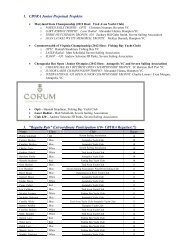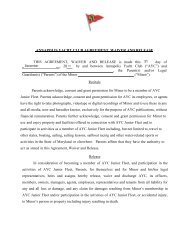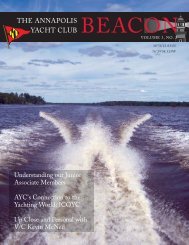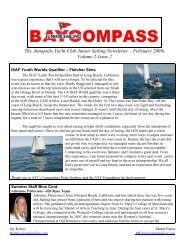Create successful ePaper yourself
Turn your PDF publications into a flip-book with our unique Google optimized e-Paper software.
In 1946, the Spring Series was started with three<br />
classes—30 Square Meters, Stars, and Chesapeake 20s.<br />
By 1948, Moths, Comets, and Hamptons were also taking<br />
part. The <strong>Annapolis</strong> to Newport Race (Newport<br />
to <strong>Annapolis</strong> back then) started in 1947 and has been<br />
run every two years since. A dining room was added to<br />
the club in the late 1940s and, in 1948, the first Smoking<br />
Lamp newsletter appeared as a single page mimeographed<br />
sheet.<br />
The junior fleet started in 1948, and the first junior<br />
trophy was presented in 1953. The first junior boat, Dolphins,<br />
was replaced by Penguins, which were next followed<br />
by the 420s that the junior fleet still races.<br />
Wednesday Night Races were the brainchild of P/C<br />
Gaither Scott. After seeing the Wednesday Night Races<br />
at East Greenwich <strong>Yacht</strong> <strong>Club</strong> in Rhode Island in 1958,<br />
Scott inaugurated midweek racing at AYC in 1959. No<br />
race committee, no prizes, and no scoring, but there was<br />
a picnic supper after sailing. “S” boats, H-23s, 5.5 meters,<br />
Bermuda One Design and Rainbows raced.<br />
By 1959, membership had risen to 1000 and a new<br />
club building was badly needed.<br />
The Modern Era, 1960–Today<br />
“We stand today on the edge of a new frontier—the<br />
frontier of the 1960s, a frontier of unknown opportunities<br />
and perils, a frontier of unfulfilled hopes and<br />
threats.” —John F. Kennedy, July 1960.<br />
The Nation. In the 60s, John F. Kennedy, after the closest<br />
presidential election in decades, set the nation off on an<br />
ambitious course. The perils were many: the Cold War<br />
with the U-2, the Berlin Wall, Castro, the Bay of Pigs<br />
and the Missile Crisis; racial tensions, riots, and assassinations;<br />
and the beginnings of Vietnam and anti-war<br />
protests. But there were also opportunities: the Peace<br />
Corps, the Civil Rights Act, The Great Society legislation,<br />
Medicare, voting rights, low income housing,<br />
cleaner air and water, a man on the moon, and nuclear<br />
nonproliferation treaties.<br />
The 70s gave us the Pentagon Papers, Watergate,<br />
Roe v. Wade, the Nixon tapes, Nixon’s Saturday Night<br />
Massacre, the Agnew resignation, Nixon’s impeachment<br />
and resignation, and Ford’s subsequent pardon, Jimmy<br />
Carter and the start of 444 days of the Iranian hostage<br />
crisis. We also had a run at the gasoline pumps and runaway<br />
inflation.<br />
The 1980s brought the country Ronald Reagan, the<br />
largest tax cuts in history, the first woman Supreme Court<br />
Justice and the first woman astronaut, along with CNN,<br />
USA Today, the MacIntosh and the mouse. In 1987, Reagan<br />
and Gorbachev signed the first ever agreement to<br />
destroy nuclear missiles, and by the end of the decade,<br />
Eastern European communist governments collapsed,<br />
the Berlin Wall fell, and the Soviet Union disintegrated.<br />
The City. So far as the waterfront is concerned, <strong>Annapolis</strong><br />
has gone through dramatic changes from the<br />
1960s to today. One has to look very hard to see any<br />
evidence of what was primarily a working waterman’s<br />
town. As any local knows full well, especially as the<br />
spring brings the first of sunny days, downtown is now a<br />
full-fledged tourist town. The <strong>Club</strong> may have decided to<br />
remain downtown, but much of downtown left for the<br />
new malls. What the <strong>Yacht</strong> Basin began in the 30s for<br />
the big boats of the East Coast, Jerry Wood’s <strong>Annapolis</strong><br />
Sailing School continued for the rest of the sailing<br />
community by starting the country’s first adult sailing<br />
classes. In 1968, the Tecumseh project stirred up controversy<br />
as it replaced an old marina and provided new<br />
residences for weekending Washingtonians. In the same<br />
year, Marmaduke’s Pub opened and became a legendary<br />
sailor’s refuge. The U.S. Sailboat and Power Boat Shows,<br />
begun in 1970, solidified <strong>Annapolis</strong>’s new claim as the<br />
sailing capital of the country.<br />
The <strong>Club</strong>. The same time frame saw the <strong>Annapolis</strong> <strong>Yacht</strong><br />
<strong>Club</strong> mature into the nationally and internationally respected<br />
yacht club of today. Just as the city changed from<br />
primarily a working class, water-oriented community to<br />
a tourist attraction and a recreational boater’s Mecca, the<br />
club expanded beyond its small boat, local race orientation<br />
into national and international one design and big<br />
boat racing and world champions and championships.<br />
The 60s laid the strong physical and personnel<br />
foundations vital to today’s constant and varied yachting<br />
activities. After some discussion and consideration of<br />
various Back Creek and Severn River sites, the club decided<br />
to remain in its downtown location, and in 1962,<br />
the old clubhouse was demolished and new construction<br />
began. In order to obtain financing, the club was<br />
required to raise membership maximums significantly.<br />
The new clubhouse opened in 1963, although the first<br />
deck remained unfinished for lack of funds. By 1969,<br />
8 AYC BEACON VOLUME 1, NO. 2


